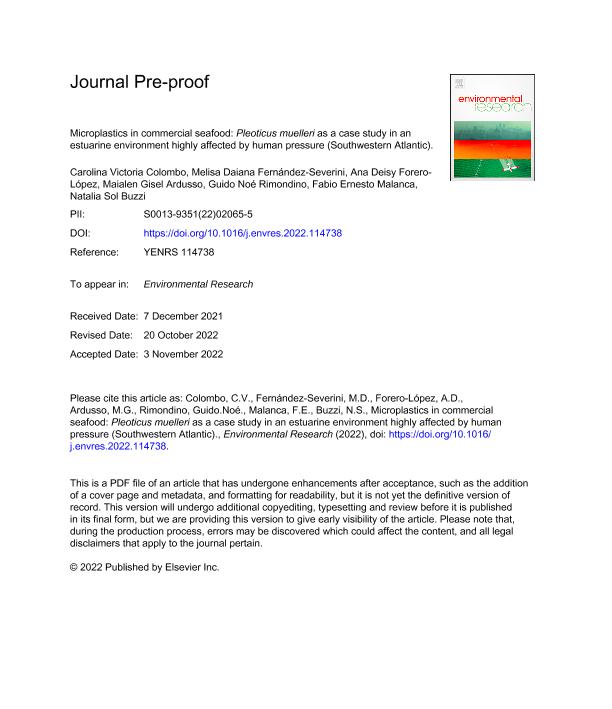Mostrar el registro sencillo del ítem
dc.contributor.author
Colombo, Carolina Victoria

dc.contributor.author
Fernandez Severini, Melisa Daiana

dc.contributor.author
Forero Lopez, Ana Deisy

dc.contributor.author
Ardusso, Maialen Gisel

dc.contributor.author
Rimondino, Guido Noé

dc.contributor.author
Malanca, Fabio Ernesto

dc.contributor.author
Buzzi, Natalia Sol

dc.date.available
2023-07-21T11:53:01Z
dc.date.issued
2022-11
dc.identifier.citation
Colombo, Carolina Victoria; Fernandez Severini, Melisa Daiana; Forero Lopez, Ana Deisy; Ardusso, Maialen Gisel; Rimondino, Guido Noé; et al.; Microplastics in commercial seafood: Pleoticus muelleri as a case study in an estuarine environment highly affected by human pressure (Southwestern Atlantic).; Academic Press Inc Elsevier Science; Environmental Research; 216; 4; 11-2022; 114738-114852
dc.identifier.issn
0013-9351
dc.identifier.uri
http://hdl.handle.net/11336/204708
dc.description.abstract
Plastic pollution in seafood has become a worldwide safety concern due to its possible harm to humans. This is the first study which has investigated the length-weight relationship, growth patterns and condition factor, together with the concentrations of microplastics (MPs) and mesoplastics (MesoPs) in Pleoticus muelleri from the Bahia Blanca Estuary (BBE), Argentina. Forty-nine individuals were collected from three sampling stations in the BBE, and each abdominal muscle with the gastrointestinal tract was analyzed. P. muelleri showed an isometric growth pattern (b = 3.0054) with values of K similar among the individuals collected (ranged between 0.80 and 0.91), considering them in good condition compared to other crustacean species around the world. 96% of shrimp presented transparent or black synthetic fibers as prevalent types, with an abundance average of (3.0 ± 2.90) MPs/g w. w. And (0.053 ± 0.16) MesoPs/g w. w. as well as a dominant size range of 0.5–1.5 mm, in accordance with recent studies in the same area. The linear regression analysis showed that K was independent of the concentration of MPs ingested by P. muelleri, with R2 ranging between 0.024 and 0.194 indicating that MPs contamination does not affect the nutritional condition of shrimp. SEM/EDX detected the presence of elements like C, O, K, and Mg, tissue residues and fractures on the surface of the analyzed fibers. FTIR confirmed different types of polymers in shrimp related to textile fabrics probably from untreated sewage discharges from nearby cities. The results of this research provide useful information for a better understanding of MPs contamination in seafood, suggesting P. muelleri as a suitable species for monitoring MPs in estuarine ecosystems. Likewise, more research is required to know the effects of MPs on food safety in humans.
dc.format
application/pdf
dc.language.iso
eng
dc.publisher
Academic Press Inc Elsevier Science

dc.rights
info:eu-repo/semantics/openAccess
dc.rights.uri
https://creativecommons.org/licenses/by-nc-nd/2.5/ar/
dc.subject
CELLULOSE
dc.subject
CONDITION FACTOR
dc.subject
EMERGING CONTAMINANTS
dc.subject
FOOD WEB
dc.subject
MICROPLASTICS
dc.subject
SHRIMP
dc.subject.classification
Otras Ciencias de la Tierra y relacionadas con el Medio Ambiente

dc.subject.classification
Ciencias de la Tierra y relacionadas con el Medio Ambiente

dc.subject.classification
CIENCIAS NATURALES Y EXACTAS

dc.title
Microplastics in commercial seafood: Pleoticus muelleri as a case study in an estuarine environment highly affected by human pressure (Southwestern Atlantic).
dc.type
info:eu-repo/semantics/article
dc.type
info:ar-repo/semantics/artículo
dc.type
info:eu-repo/semantics/publishedVersion
dc.date.updated
2023-07-07T17:32:30Z
dc.journal.volume
216
dc.journal.number
4
dc.journal.pagination
114738-114852
dc.journal.pais
Países Bajos

dc.journal.ciudad
Amsterdam
dc.description.fil
Fil: Colombo, Carolina Victoria. Consejo Nacional de Investigaciones Científicas y Técnicas. Centro Científico Tecnológico Conicet - Bahía Blanca. Instituto Argentino de Oceanografía. Universidad Nacional del Sur. Instituto Argentino de Oceanografía; Argentina
dc.description.fil
Fil: Fernandez Severini, Melisa Daiana. Consejo Nacional de Investigaciones Científicas y Técnicas. Centro Científico Tecnológico Conicet - Bahía Blanca. Instituto Argentino de Oceanografía. Universidad Nacional del Sur. Instituto Argentino de Oceanografía; Argentina
dc.description.fil
Fil: Forero Lopez, Ana Deisy. Consejo Nacional de Investigaciones Científicas y Técnicas. Centro Científico Tecnológico Conicet - Bahía Blanca. Instituto Argentino de Oceanografía. Universidad Nacional del Sur. Instituto Argentino de Oceanografía; Argentina
dc.description.fil
Fil: Ardusso, Maialen Gisel. Consejo Nacional de Investigaciones Científicas y Técnicas. Centro Científico Tecnológico Conicet - Bahía Blanca. Instituto Argentino de Oceanografía. Universidad Nacional del Sur. Instituto Argentino de Oceanografía; Argentina
dc.description.fil
Fil: Rimondino, Guido Noé. Consejo Nacional de Investigaciones Científicas y Técnicas. Centro Científico Tecnológico Conicet - Córdoba. Instituto de Investigaciones en Físico-química de Córdoba. Universidad Nacional de Córdoba. Facultad de Ciencias Químicas. Instituto de Investigaciones en Físico-química de Córdoba; Argentina
dc.description.fil
Fil: Malanca, Fabio Ernesto. Consejo Nacional de Investigaciones Científicas y Técnicas. Centro Científico Tecnológico Conicet - Córdoba. Instituto de Investigaciones en Físico-química de Córdoba. Universidad Nacional de Córdoba. Facultad de Ciencias Químicas. Instituto de Investigaciones en Físico-química de Córdoba; Argentina
dc.description.fil
Fil: Buzzi, Natalia Sol. Universidad Nacional del Sur; Argentina. Consejo Nacional de Investigaciones Científicas y Técnicas. Centro Científico Tecnológico Conicet - Bahía Blanca. Instituto Argentino de Oceanografía. Universidad Nacional del Sur. Instituto Argentino de Oceanografía; Argentina
dc.journal.title
Environmental Research

dc.relation.alternativeid
info:eu-repo/semantics/altIdentifier/doi/http://dx.doi.org/10.1016/j.envres.2022.114738
dc.relation.alternativeid
info:eu-repo/semantics/altIdentifier/url/https://www.sciencedirect.com/science/article/pii/S0013935122020655
Archivos asociados
